
Podocarpaceae is a large family of mainly Southern Hemisphere conifers, known in English as podocarps, comprising about 156 species of evergreen trees and shrubs. It contains 19 genera if Phyllocladus is included and Manoao and Sundacarpus are recognized.
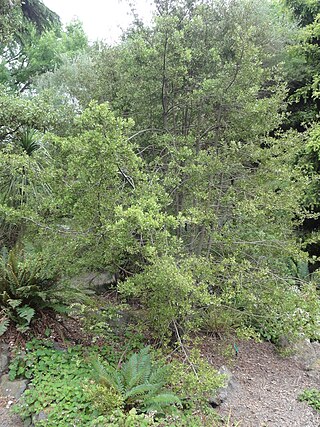
Phyllocladus, the celery pines, is a small genus of conifers, now usually placed in the family Podocarpaceae.Species occur mainly in New Zealand, Tasmania, and Malesia in the Southern Hemisphere, though P. hypophyllus ranges into the Philippines, a short way north of the equator.
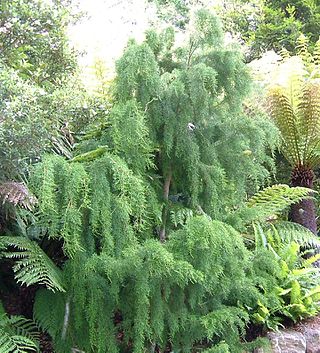
Lagarostrobos franklinii is a species of conifer native to the wet southwestern corner of Tasmania, Australia. It is often known as the Huon pine or Macquarie pine, although it is actually a podocarp (Podocarpaceae), not a true pine (Pinaceae). It is the sole species in the genus Lagarostrobos; one other species L. colensoi formerly included has been transferred to a new genus Manoao. The genus was also formerly included in a broader circumscription of the genus Dacrydium.

Podocarpus is a genus of conifers, the most numerous and widely distributed of the podocarp family, the Podocarpaceae. The name comes from Greek πούς + καρπός. Podocarpus species are evergreen shrubs or trees, usually from 1 to 25 m tall, known to reach 40 m (130 ft) at times. The cones have two to five fused cone scales, which form a fleshy, berry-like, brightly coloured receptacle at maturity. The fleshy cones attract birds, which then eat the cones and disperse the seeds in their droppings. About 97 to 107 species are placed in the genus depending on the circumscription of the species.

Nageia is a genus of conifers belonging to the podocarp family Podocarpaceae. Nageia includes evergreen shrubs and trees, from one to 54 meters in height. A 2009 treatment of the genus recognized five species. Some authors consider Nageia formosensis to be a separate species from Nageia nagi, thus recognizing six species. The podocarp genera have been reshuffled by various botanists. Most recently, several species formerly classed as Nageia were moved to the new genus Retrophyllum, while Nageia falcata and Nageia mannii were moved to the new genus Afrocarpus.
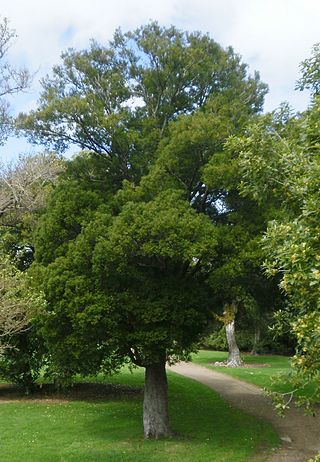
Prumnopitys is a genus of conifers belonging to the family Podocarpaceae. The nine recognized species of Prumnopitys are densely branched, dioecious evergreen trees up to 40 metres in height.

ManoaoMAH-noh-ow is a monotypic genus in the family Podocarpaceae. The single species, M. colensoi, known as manoao (Māori), silver pine, Westland pine, or white silver pine, is endemic to New Zealand. Before 1996 it was classified in genus Dacrydium or Lagarostrobos, but has recently been recognised as a distinct genus; some botanists still treat it in Lagarostrobos on the basis that it is not phylogenetically distinct from that genus. In molecular phylogenetic analyses Manoao was found to be related to Parasitaxus and Lagarostrobos, but their exact relationships are unresolved.

Saxegothaea is a genus comprising a single species, Saxegothaea conspicua. It is a conifer in the podocarp family Podocarpaceae, native to southern South America. It grows in Chile and Argentina from 35° to 46° South latitude; in its northernmost natural distribution it grows between 800 and 1000 (2600–3300 ft) m above sea level and in the south it lives at sea level. The species is most often known by its genus name, or sometimes as female maniu and Prince Albert's yew; in South America it is known as mañío hembra or maniú hembra.

Prumnopitys andina, the lleuque or Chilean plum yew, is an evergreen coniferous tree native to south-central Chile and a few areas in adjacent parts of westernmost Argentina from 36 to 40° South latitude. It lives on moderately wet soils, preferably on Andean slopes from 500–1,100 meters (1,600–3,600 ft).

Microcachrys tetragona, the creeping pine or creeping strawberry pine, is a species of dioecious conifer belonging to the podocarp family (Podocarpaceae). It is the sole species of the genus Microcachrys. The plant is endemic to western Tasmania, where it is a low shrub growing to 1 m tall at high altitudes. Its leaves are scale-like, arranged in opposite decussate pairs, superficially resembling those of the unrelated Diselma archeri (Cupressaceae). It shares the common name Creeping pine with several other plants. Females produce tiny, red, edible berries in summer.
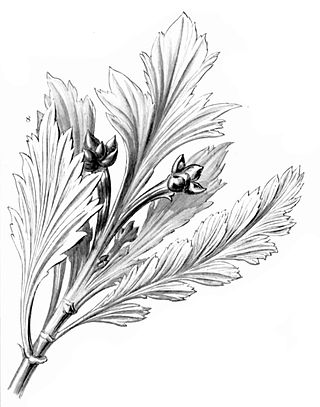
Phyllocladus aspleniifolius, commonly known as the celerytop pine, is an endemic gymnosperm of Tasmania, Australia. It is widespread and common in Tasmania, with the most abundance in the western highlands. Its ‘leaves’ appear similar to those of a celery plant, hence the common name.
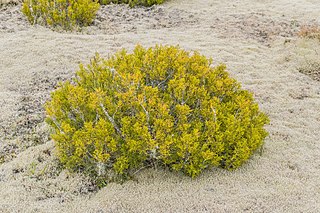
Halocarpus bidwillii, commonly known as the mountain pine or bog pine, is a species of conifer in the family Podocarpaceae. It is endemic to New Zealand.
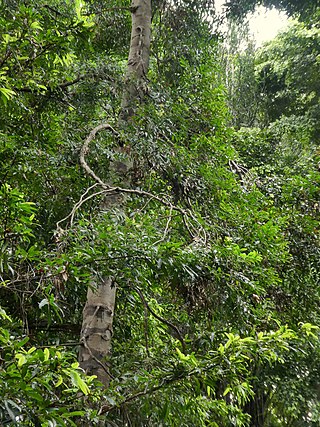
Agathis atropurpurea, commonly known as the blue kauri, and occasionally as the black kauri or purple kauri, is a species of conifer in the very ancient plant family Araucariaceae. The family was distributed almost worldwide during the Jurassic and Cretaceous periods, but is now mostly confined to the Southern Hemisphere. This species is endemic to a small part of northeastern Queensland, Australia.
Dacrydium gracile is a species of conifer in the family Podocarpaceae. It is found only in Malaysian Borneo.

Lepidothamnus laxifolius, commonly known as the pygmy pine or mountain rimu, is a species of conifer in the family Podocarpaceae. It is endemic to New Zealand, where it is found in the North Island, the South Island and on Stewart Island.
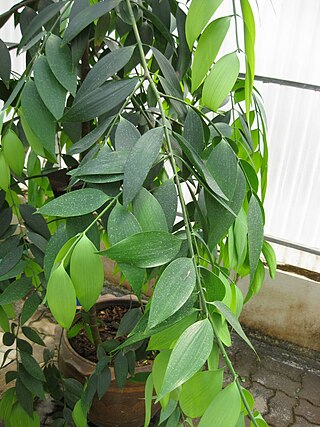
Nageia wallichiana is a species of conifer in the family Podocarpaceae. It is a tree 10–54 m high, found in Brunei, Cambodia, China, India, Indonesia, Laos, Malaysia, Myanmar, Thailand, and Vietnam. Nageia wallichiana is the most widely distributed species among the seven species in the genus Nageia. If the land areas of China and Japan are excluded, its distribution nearly coincides with that of the genus and includes both the western outliers in India and the easternmost part on Normanby Island. It is one of the most extensive conifer ranges recognized and is similar to Dacrycarpus imbricatus and Podocarpus neriifolius.

Podocarpus grayae is a species of conifer in the family Podocarpaceae, which is endemic to Australia. It is found only in the Northern Territory and Queensland.
Podocarpus laubenfelsii is a species of conifer in the family Podocarpaceae. It is native to Borneo.

Podocarpus nivalis, the mountain or snow tōtara, is a species of conifer in the family Podocarpaceae. It is endemic to New Zealand.

Podocarpus smithii is a species of conifer in the family Podocarpaceae. It is found only in Queensland, Australia.



















